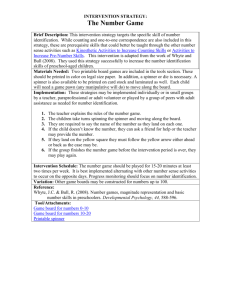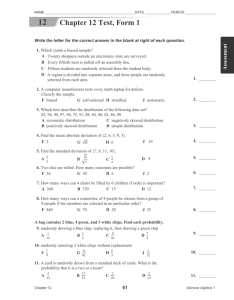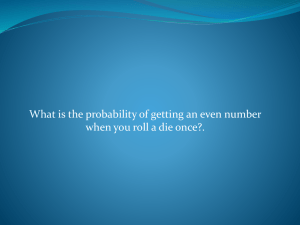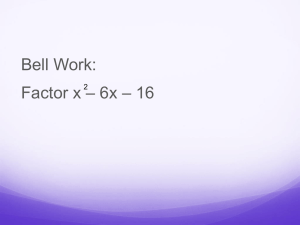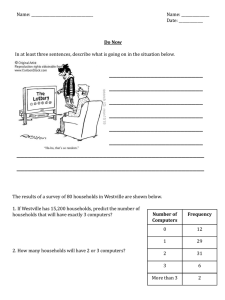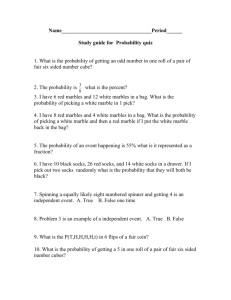8.3 - Teacherpage
advertisement
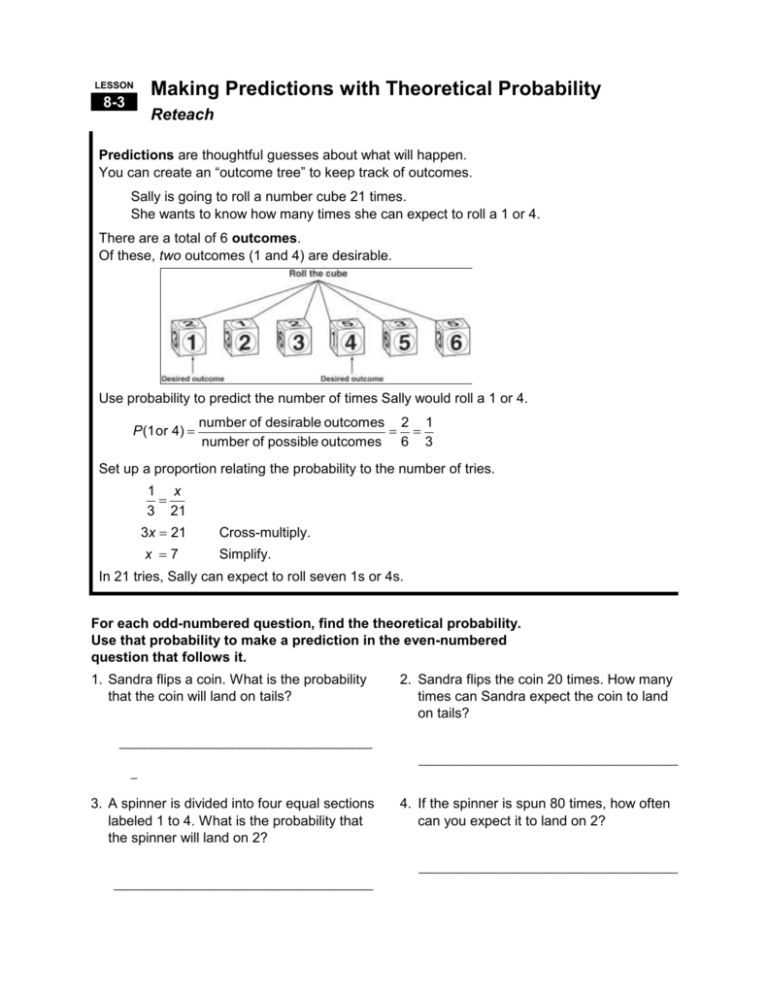
LESSON 8-3 Making Predictions with Theoretical Probability Reteach Predictions are thoughtful guesses about what will happen. You can create an “outcome tree” to keep track of outcomes. Sally is going to roll a number cube 21 times. She wants to know how many times she can expect to roll a 1 or 4. There are a total of 6 outcomes. Of these, two outcomes (1 and 4) are desirable. Use probability to predict the number of times Sally would roll a 1 or 4. P (1 or 4) number of desirable outcomes 2 1 number of possible outcomes 6 3 Set up a proportion relating the probability to the number of tries. 1 x 3 21 3x 21 Cross-multiply. x 7 Simplify. In 21 tries, Sally can expect to roll seven 1s or 4s. For each odd-numbered question, find the theoretical probability. Use that probability to make a prediction in the even-numbered question that follows it. 1. Sandra flips a coin. What is the probability that the coin will land on tails? 2. Sandra flips the coin 20 times. How many times can Sandra expect the coin to land on tails? ________________________________________ _________________________________________ _ 3. A spinner is divided into four equal sections labeled 1 to 4. What is the probability that the spinner will land on 2? 4. If the spinner is spun 80 times, how often can you expect it to land on 2? _________________________________________ _________________________________________ LESSON 8-3 Making Predictions with Theoretical Probability Practice and Problem Solving: A/B In each odd-numbered question, find the theoretical probability. Then use that probability to make a prediction in the even-numbered question that follows it. 1. Martin flips a fair coin. What is the probability that the coin will land on heads? 2. Martin flips the coin 64 times. How many times can Martin expect the coin to land on heads? _______________________________________ ________________________________________ 3. A spinner is divided into five equal sections labeled 1 to 5. What is the probability that the spinner will land on 3? 4. If the spinner is spun 60 times, how many times can you expect the spinner to land on 3? _______________________________________ ________________________________________ 5. Harriet rolls a number cube. What is the probability that the number cube will land on 3 or 4? 6. If Harriet rolls the number cube 39 times, how many times can she expect to roll a 3 or 4? _______________________________________ ________________________________________ 7. A bag contains 6 red and 10 black marbles. If you pick a marble from the bag, what is the probability that the marble will be black? 8. If you pick a marble, record its color, and return it to the bag 200 times, how many times can you expect to pick a black marble? _______________________________________ ________________________________________ Make a prediction based on the theoretical probability. 9. Gill rolls a number cube 78 times. How many times can he expect to roll an odd number greater than 1? 10. Jenna flips two pennies 105 times. How many times can she expect both coins to come up heads? _______________________________________ 11. A shoebox holds a number of disks of the same size. There are 5 red, 6 white, and 7 blue disks. You pick out a disk, record its color, and return it to the box. If you repeat this process 250 times, how many times can you expect to pick either a red or white disk? _______________________________________ ________________________________________ 12. Ron draws 16 cards from a deck of 52 cards. The deck is made up of cards of four different colors—red, blue, yellow, and green. How many of the cards drawn can Ron expect to be green? ________________________________________ LESSON 8-3 Making Predictions with Theoretical Probability Practice and Problem Solving: C 1. Kamila has two number cubes each labeled 1 to 6. She is going to conduct an experiment by tossing both cubes a total of 150 times. She will find the sum of the two numbers in each roll. a. How many possible outcomes are there? _________________ b. What is the probability of tossing a sum of 6? _________________ c. How many times should Kamila toss a sum of 7? ________________ d. How many times should Kamila toss a sum of 10 or greater? _____________________________________ 2. Eric has two number cubes each labeled 1 to 6. Eric is going to conduct an experiment by tossing the cubes a total of 180 times. He will find the product of the two numbers in each roll. a. How many possible outcomes are there? _________________ b. How many times should Eric toss a product of 12? _________________ c. How many times should Eric toss a product greater than 20? _____________________________________ d. How many times should Eric toss a product less than 10? _____________________________________ 3. Natalie has two number pyramids each labeled 1 to 4. Natalie is going to conduct an experiment by tossing both pyramids a total of 96 times. She will find the difference of each pair of numbers rolled by subtracting the lesser number from the greater number. a. How many possible outcomes are there? _________________ b. How many times should Natalie toss a difference of 1? ______________ c. How many times should Natalie toss a difference of 0? ______________ Practice and Problem Solving: D Find the probability of each event. The first one is done for you. 1. Arjan flips a quarter. What is the 2. Stephanie rolls a number cube that has probability of the quarter landing tails up? sides numbered from 1 to 6. What is the 1 _______________________________________ 2 3. What is the probability of spinning this spinner and having it land on B? _______________________________________ E A B D C probability of the cube landing on either 2 or 5? ________________________________________ 4. Jonathan has a bag that has 2 red marbles and 3 blue marbles inside of it. If you were to pick one marble from the bag without looking, what is the probability of picking a red marble? ________________________________________ Make a prediction based on a theoretical probability. Show your work. The first one is done for you. 5. The probability of flipping a coin and 1 having it land on heads is . If a coin is 2 tossed 4 times, how many times can you expect it to land on heads? 1 1 4 4 4 2 _______________________________________ 2 2 1 2 7. The probability of a number cube landing 1 on 4 is . If a number cube is tossed 6 12 times, how many times can it be expected to land on 4? _______________________________________ 6. A spinner is divided into 4 equal sections. 1 The probability of landing on A is . 4 Norma spins the spinner 16 times. How many times can she expect the spinner to land on A? ________________________________________ 8. The probability of picking a blue pen from 1 a cup of pens is . Tim picks one pen 3 from the cup without looking, records the color, and puts the pen back. He does this 15 times. How many times can he expect to pick a blue pen? ________________________________________ Name _______________________________________ Date __________________ Class __________________ Practice and Problem Solving: C LESSON 8-3 1. a. 36 Practice and Problem Solving: A/B b. 1 1. 2 5 36 c. 25 2. 32 d. 25 1 3. 5 2. a. 36 b. 20 4. 12 1 3 c. 30 6. 13 3. a. 16 5 8 b. 36 5. 7. d. 85 c. 24 8. 125 Practice and Problem Solving: D 9. 26 10. about 26 1. 1 2 2. 1 3 3. 1 5 4. 2 5 5. 1 1 4 4 4 2 2 2 1 2 6. 1 1 16 16 16 4 4 4 1 4 7. 1 1 12 12 12 2 6 6 1 6 8. 1 1 15 15 15 5 3 5 1 3 11. about 153 12. 4 Reteach 1. 1 2 2. 10 3. 1 4 4. 20 Original content Copyright © by Houghton Mifflin Harcourt. Additions and changes to the original content are the responsibility of the instructor. 179


